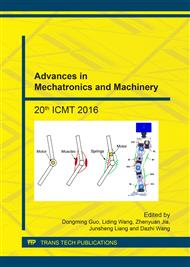[1]
W Zhang, S Sun. Scale-related topology optimization of cellular materials and structures, International Journal for Numerical Methods in Engineering. 68(2006)993–1011.
DOI: 10.1002/nme.1743
Google Scholar
[2]
G.D. Cheng. On Non-Smoothness in Optimal Design of Solid Elastic Plates, International Journal of Solids and Structures, 17(1981)795-810.
DOI: 10.1016/0020-7683(81)90089-5
Google Scholar
[3]
M P Bendsøe, N Kikuchi. Generating optimal topologies in structural design using homogenization method, Computer Methods in Applied Mechanics and Engineering. 71(1988) 197-224.
DOI: 10.1016/0045-7825(88)90086-2
Google Scholar
[4]
M P Bendsøe. Optimal shape design as a material distribution problem, Structural Optimization. 1(1989): 192-202.
DOI: 10.1007/bf01650949
Google Scholar
[5]
G Rozvany. A critical review of established methods of structural topology optimization, Structural and Multidisciplinary Optimization. 37 (2009)217–237.
DOI: 10.1007/s00158-007-0217-0
Google Scholar
[6]
G Pingen. A parametric level-set approach for topology optimization of flow domains, Structural and Multidisciplinary Optimization. 41 (2010)117–131.
DOI: 10.1007/s00158-009-0405-1
Google Scholar
[7]
Yi G, B D Youn. A comprehensive survey on topology optimization of phononic crystals, Structural and Multidisciplinary Optimization. 54(2016) 1315-1344.
DOI: 10.1007/s00158-016-1520-4
Google Scholar
[8]
A Dugré, A Vadean, and J Chaussée. Challenges of using topology optimization for the design of pressurized stiffened panels, Structural and Multidisciplinary Optimization. 53(2016)303-320.
DOI: 10.1007/s00158-015-1321-1
Google Scholar
[9]
J Zhu, W Zhang, L Xia. Topology Optimization in Aircraft and Aerospace Structures Design, Archives of Computational Methods in Engineering. 23(2016) 595-622.
DOI: 10.1007/s11831-015-9151-2
Google Scholar
[10]
J Li, S Chen, and H Huang. Topology optimization of continuum structure with dynamic constraints using mode identification, Journal of Mechanical Science and Technology. 29(2015) 1407-1412.
DOI: 10.1007/s12206-015-0311-y
Google Scholar
[11]
S Zargham. Topology optimization: a review for structural designs under vibration problems, Structural and Multidisciplinary Optimization. 53(2016) 1157-1177.
DOI: 10.1007/s00158-015-1370-5
Google Scholar
[12]
J Yan, G D Cheng, L Liu, S T Liu. Concurrent material and structural optimization of hollow plate with truss-like material, Struct Multidisc Optim. 35 (2008) 153-163.
DOI: 10.1007/s00158-007-0124-4
Google Scholar
[13]
B Niu, J Yan, G D Cheng. Optimum structure with homogeneous optimum cellular material for maximum fundamental frequency, Structural and Multidisciplinary Optimization, 29(2009) 115-132.
DOI: 10.1007/s00158-008-0334-4
Google Scholar


